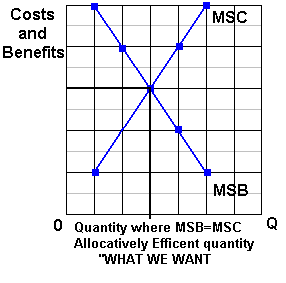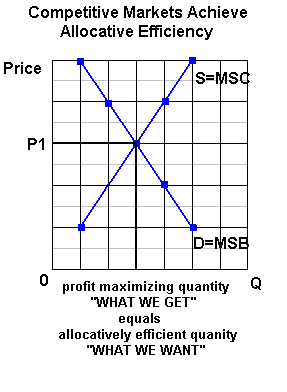
A purely competitive economy is an efficient economy, both allocatively and productively, but there is no mechanism to make them achieve equity or full employment. (5Es).
PRODUCTIVE EFFICIENCY - Competition, or capitalism, through freedom of entry and exit ensures that production occurs at the lowest possible average cost and that there is no waste in production. Competition ensures production occurs at a minimum cost or other businesses will be able to produce and sell the product for cheaper. Inefficient businesses will be beat by their productively efficient competitors.
EQUITY - Positive economic analysis cannot directly address the fairest way to divide the pie. The proper distribution of income is a normative problem at best settled in the political arena.
ALLOCATIVE EFFICIENCY - Allocative efficiency requires the mix of goods produced to match consumer preferences. Here again, competition meets the criterion because consumers get the products they want at the least opportunity cost. Your demand curve for any good is based on the marginal benefits (utility) that you would receive from consuming various possible amounts of the good, as we discussed when we explained the law of demand. Our assumptions imply that the marginal utility you receive from consuming is also the marginal benefit society receives. That is, your gain is also society’s gain because you are a member of society. When we sum all consumer demands, we derive the market demand curve for an industry’s product, which is also the marginal social benefit (MSB) to all of society from having a bit more of the good. Therefore D = MSB.
With consumer benefits and producer costs in mind, we can refer to the industry supply and demand curves, respectively, as the marginal social cost (MSC) and marginal social benefit (MSB) curves. When a purely competitive industry is in a long-run equilibrium, quantity supplied equals quantity demanded (this is the profit maximizing quantity) AND therefore marginal social cost equals marginal social benefit (MSC = MSB), this is the allocatively efficient quantity. The industry is producing where the marginal social benefit from the last unit produced is just equal to the marginal social cost of the resources needed to produce that unit of product. This concept is illustrated in the figure below.

The MSB = MSC condition is optimal from society’s point of view. Since the opportunity costs of resources represent alternatives for all of society, we want our resources to be used as efficiently as possible. If production were inefficient, then it would be possible for some people to gain without imposing losses on others.
Consider output level slightly less than the efficient quantity shown above. The social benefit from a bit more output than the cost of the resources required to produce a little more of the good (MSB>MSC), so society as a whole could gain if more resources were used to produce more of this good. And in a competitive industry, they will be. If this small quantity were initially produced and sold, existing firms in a competitive industry would enjoy economic profit. This would cause the industry to grow until the allocatively efficient quantity is reached. The adjustment process is just reversed if industry output exceeds the efficient level of output.
|
|
|

Modified from Microeconomics by Ralph T. Burns and Gerald M. Stone, Harper Collins, New York 1993, pp. 210-212